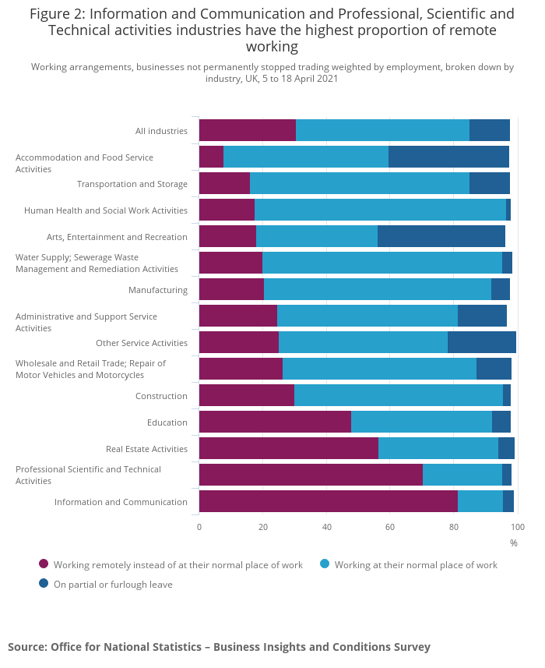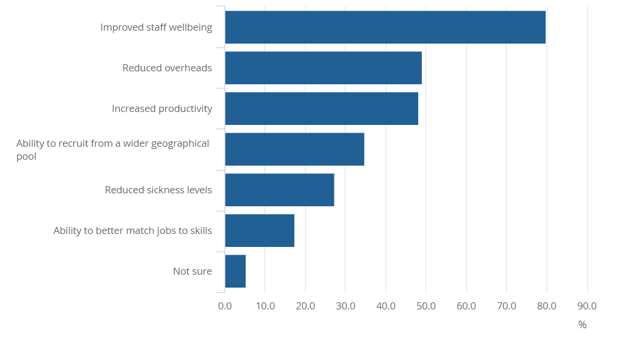Hybrid working statistics: The state of hybrid in 2022
By Tara Clarke
It’s hard to avoid the topic of hybrid working. With world-leading companies like Twitter announcing hybrid policies and stalwarts like the Bank of England reportedly being forced to make the transition, hybrid represents a shift in the way we work that’s impossible to ignore.
In this blog post, we’ve rounded up statistics that paint an interesting picture of hybrid working in 2022. As momentum builds and employees start to see the benefits, those businesses who keep themselves abreast of the conversation stand to benefit most.
So here are the key takeaways, and below you’ll find accompanying analysis of their wider implications:
- There is demand amongst employees to work from home at least some of the time
- This demand arises from perceived or experienced benefits
- There is wariness amongst employers, but some see the benefits
- There are practical considerations, but employees are aware of them
- Both sides stand to benefit from having the conversation
- Not every industry is suited to hybrid working
- Hybrid working tends to be more prevalent in higher paid roles
- Hybrid working is more common in certain age brackets
- There are viable routes to hybrid working for businesses who want them
There is demand amongst employees to work from home at least some of the time
Since the Covid-19 pandemic shifted the way we work, employee attitudes to how and where they want to work have been shifting, too.
This is clearly evidenced by findings from the Accenture Future of Work Study 2021:
“A majority of workers (83%) prefer a hybrid work model.”
And a report by the Office of National Statistics (ONS) drills a little deeper to corroborate this:
“84% of workers who had to work from home because of the coronavirus pandemic said they planned to carry out a mix of working at home and in their place of work in the future.”
“The proportion who planned to return to their place of work permanently fell from 11% in April 2021 to 8% in February 2022.”
“The proportion of workers hybrid working has risen from 13% in early February 2022 to 24% in May 2022.”
When asked how they plan to split their time between working in an office and working from home, the only two responses whose vote share increased between April 2021 and February 2022 were those with a majority of time spent at home:
This demand arises from perceived or experienced benefits
Another piece of research from the ONS shows that employees have good reason to move toward a hybrid work model:Another piece of research by the ONS demonstrates that the reasons that an increasing number of employees want the option to work in a hybrid model are coherent and compelling:
“More than three-quarters (78%) of those who worked from home in some capacity said that being able to work from home gave them an improved work life balance.”
“Half reported it was quicker to complete work (52%)”
“Almost half also reported improved well-being (47%).”
There is wariness amongst employers, but some see the benefits
While demand may be increasing amongst employees, employers have their concerns about hybrid working.
“[T]here was some uncertainty among businesses, with 32% stating they were not sure what proportion of the workforce will be working from their usual place of work.”
But that’s not to say that all organisations can’t see the benefits:
“The most common reason for using or planning to use home working as part of a permanent business model was improved staff well-being (60%), followed by reduced overheads (43%) and increased productivity (41%).”
Other factors perceived as favourable included reduced carbon emissions, ability to recruit from a wider geographical pool, and an ability to better match jobs to skills.
There are practical considerations, but employees are aware of them
Many potential challenges are cited in conversations about hybrid working. Will staff be able to work smoothly together from different locations, for example? Or how will office space be managed efficiently?
Interestingly, another piece of research by the ONS found that employees are aware of the potential challenges that hybrid working presents:
“When asked about home working, working adults stated work-life balance was the greatest positive, while challenges of collaboration were the greatest negative.”
There is variation between age groups on how various issues are perceived, and the grouping of different issues lends itself well to tailored solutions:
A majority of all employees surveyed thought that hybrid working led to quicker completion of work and improved wellbeing. Only younger employees found that they experienced more distractions from home.
And while a majority of all respondents found it harder to think of new ideas or work with others at home, industry solutions like project tracking software or staff location tracking exist to alleviate such issues. Businesses that are willing to adopt such solutions stand to benefit from an evolving approach to work.
These findings suggest that employees can be involved in the conversation about how to manage challenges that hybrid working may represent, and that employers simply citing the possibility of these challenges may not be considered grounds enough to reject hybrid working outright.
Both sides stand to benefit from having the conversation
It seems inevitable that the hybrid working conversation will continue, as wariness from employers is unlikely to be enough to quell increased demand from employees.
Momentum is gathering, in some areas more quickly than others:
“24% [of businesses] stated that they intended to use increased homeworking going forward, with the Information and Communication industry recording the highest proportion (49%).
The high proportion from this industry correlates to their position in the following graph, which shows the industries that had the highest proportion of homeworking during the Covid-19 pandemic:

Not every industry is suited to hybrid working
The nature of the industries with low percentages of staff working remotely speaks to the fact that hybrid working isn’t a good fit for every business. Some industries necessitate much higher levels of physical presence, to the point where hybrid will be greatly reduced, or even made impossible.
Industries’ willingness to move toward hybrid work models in future correlates with the proportion of their staff who worked remotely during Covid:
“There is a positive relationship between current remote working practices and future homeworking intentions.”
Hybrid working tends to be more prevalent in higher paid roles
Just as there are differences in industries’ suitability to hybrid working, there are notable differences in proportion of hybrid workers between income brackets:
“More than a third (38%) of workers earning £40,000 or more hybrid worked between 27 April and 8 May 2022.”
“32% of those earning between £30,000 and £40,000 [hybrid worked]”
“21% of those earning between £20,000 and £30,000 [hybrid worked]”
“24% of those earning between £15,000 and £20,000 [hybrid worked]”
“8% of those earning up to £15,000 [hybrid worked]”
“Occupations with lower average earnings, such as gardeners, carpenters and mechanics, were less likely to be able to work from home.”
This is a reminder that while the hybrid working conversation may be more prevalent, not all UK workers stand to benefit. Lower earning roles correlate with those which require a physical presence and/or the usage of specific equipment, reducing the suitability of the work being done remotely.
Employers need to be aware of this divide, and ensure that conversations about the evolving nature of work don’t leave behind those unable to work remotely.
Hybrid working is more common in certain age brackets
As with income brackets, hybrid working is split differently between different age brackets:
“Workers aged 30 to 49 years were the most likely to report hybrid working between 27 April and 8 May 2022, with 29% reporting doing so.”
This is another question for employers to ask: how can we ensure that any movement we make towards an increased ratio of hybrid working is fair for everyone?
There are viable routes to hybrid working for businesses who want them
As we’ve seen, there is a conversation happening and there are myriad factors on both sides that are worthy of consideration. And for businesses who do decide to adopt more hybrid working practices, the transition may feature occasional hiccups.
But as Accenture concisely summarise:
“Responsible leaders must move beyond physical location to shape the future of work by giving people resources tailored to their needs.”
There’s no option to ignore the issue. Instead, those businesses who familiarise themselves with the advantages and disadvantages, and use these to make a considered decision - ideally with the involvement of their employees - stand to benefit most.
And remember: there are plenty of technological solutions designed to facilitate hybrid working. Our range of HR software is built to integrate into any organisation, and offers a comprehensive suite of tools to enable a smooth transition to hybrid.
Our experts can demonstrate the various features best suited to hybrid working on a software demo, or if you’d rather a more hands-on approach you can try our software for free for 14 days.
.webp?height=168&name=appogeehr%20(1).webp)




